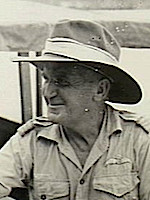General Information
Distinguished Flying Cross
Air Force Cross
Award Citations
Military Cross
For conspicuous gallantry and devotion to duty. On a recent occasion he flew to an aerodrome fifteen miles behind the enemy lines, descended to within twenty feet of the ground and fired into eight hostile machines. On his return journey he attacked a train with considerable effect from a low altitude. He has in addition brought down several enemy machines, and has always set a splendid example of fearlessness and devotion to duty in attacking enemy balloons and troops on the ground.
Gazetted: The London Gazette, 9 January 1918
Distinguished Flying Cross
A gallant flight commander, who in the last three months has destroyed two enemy machines and driven down four out of control. Recently, whilst on special patrol, he, single-handed, attacked four enemy aeroplanes; having driven down one out of control, he engaged the leader, damaged his engine, and compelled him to glide to his lines. One of the remaining machines followed the leader, but he attacked the other and drove it down in a steep dive.
Gazetted: The London Gazette, 2 August 1918
Air Force Cross
Squadron Leader PENTLAND joined the RAAF on 17th June, 1940, and served as a flying instructor for two years. In June, 1942, he was posted to No. 1 Communication Flight and later to Rescue and Communication Squadron. He was appointed to command No. 3 Communication Unit in November, 1943, and No. 8 Communication Unit in February, 1944.
In June, 1942, he carried out the rescue of seven American personnel who had crashed in the Upper Ramu Valley. He also rescued several civilians and AIF personnel who had escaped from Rabaul, and later again rescued some American personnel who had crashed at Dedele Point.
In July and early August, 1942, Squadron Leader PENTLAND carried out an extensive survey of all beaches between Daru and Milne Bay in order to establish emergency landing grounds, and all suitable beaches thus discovered were then notified to all Allied air units operating in the area. A base with a small store of petrol and wireless communication was established on the beach at Kerema, and this was used as an emergency landing ground in bad weather by aircraft of all descriptions.
He personally surveyed three disused civil airstrips in North-West Papua and British New Guinea, and arranged with the local ANGAU and natives for their clearing, draining and maintenance, and also for three new strips between Port Moresby and Milne Bay.
Squadron Leader PENTLAND flew approximately 200 hours in Moth and D.H.84 aircraft while carrying out this important work which resulted in the saving of many valuable aircraft and crews.
Squadron Leader PENTLAND has, at all times, displayed outstanding courage, initiative and skill, and these qualities, together with his excellent knowledge of New Guinea and its climatic conditions, have made his services invaluable, not only to the RAAF, but to the U.S. Army Air Forces and the New Guinea Forces as well.


